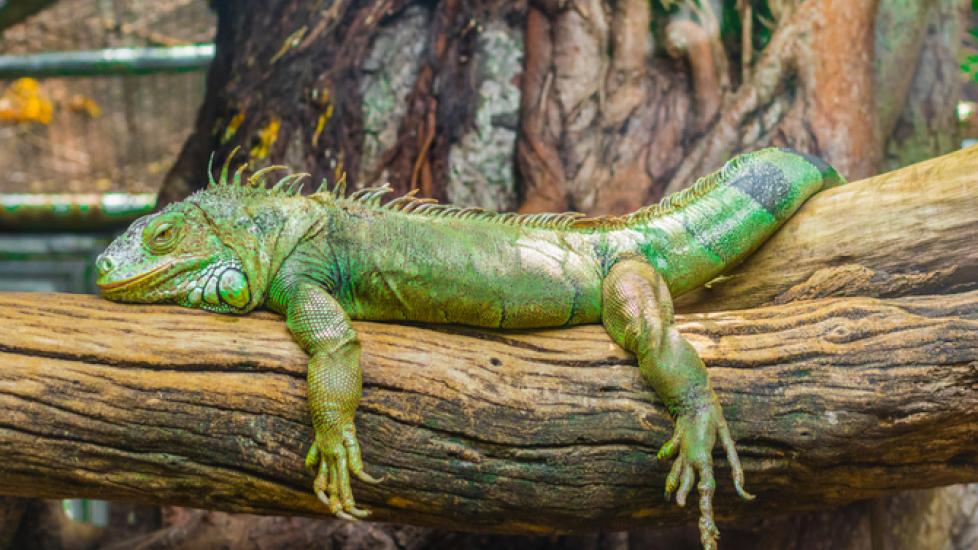Hypothermia in Reptiles
By Laurie Hess, DVM, Diplomate ABVP (Avian Practice)
Reptiles are ectotherms — cold-blooded animals whose body temperature regulation depends on external sources, such as direct sunlight or a heater. Without external heat sources, all reptiles — snakes, lizards, turtles, and tortoises — become hypothermic, meaning their body temperature declines. As a result, they become less active, their digestion slows, their immune system doesn’t function properly, and they become susceptible to secondary infections.
Different species of reptiles live best at different temperature ranges — called their preferred optimal temperature zone (POTZ). A reptile’s POTZ depends on what geographic location the reptile species originated and what type of terrain (e.g., desert vs. rain forest vs. temperate forest, etc.) the species typically inhabits. Unfortunately, too many reptile owners purchase or adopt their pets without first researching the environmental conditions the animal requires to thrive, and as a result, the pet becomes hypothermic and gets sick.
What Are the Signs of Hypothermia in Reptiles?
Regardless of species, hypothermic reptiles become less active and move less. Eventually, they stop moving altogether. Lizards, in particular, stop pushing up on their legs and instead lie stationary on their bellies. Snakes stop slithering, turtles stop swimming, and tortoises often enclose themselves in their shells and sit like paperweights.
When reptiles stop moving, they often stop eating and drinking, and as a result, they become dehydrated and lose weight. Their eyes appear sunken, both from dehydration and from loss of fat that normally sits behind their eyes. They often close their eyes, as well. Their skin may appear more wrinkled from this loss of water and fat, and both snakes and lizards may have more prominent spines and ribs as they lose weight.
Finally, with dehydration, many snakes and lizards stop shedding their skin properly and shedding skin appears retained in patches over their bodies. Hypothermic, dehydrated turtle and tortoise skin also may appear dry and cracked, and often these reptiles stop shedding the tile-like keratin protein plates (scutes) on their shells that normally come off as they grow. As a result, scutes pile up on top of each other when new scutes grow in under the old retained ones, a condition referred to in reptiles as pyramiding.
What Should a Reptile Owner Do if They Suspect a Pet Reptile is Hypothermic?
Any reptile owner who suspects that their pet may be hypothermic should immediately measure the temperature in the pet’s tank, both at the warmest and the coolest areas, to determine the temperature range in the enclosure. The easiest way to do this is with an automatic temperature gun, available at most pet stores, that you simply aim and shoot to see the temperature of a particular spot. If such a device isn’t available, a simple thermometer dropped into the enclosure will at least give a crude measurement.
Owners measuring tank temperatures should be sure to place or aim the thermometer down to the bottom of the enclosure, where the pet actually sits, as there can be a huge temperature difference between the temperature on the floor of the tank and that of the air at the top. The owner should compare this measurement to what is optimal for the pet’s species and immediately warm the enclosure if it is too cool. In addition, misting or soaking the pet in a shallow pan of warm water to both warm it up and better hydrate it also can help.
To ensure the animal is being housed and fed optimally and to check for any infection secondary to the hypothermia, the reptile owner should have the pet checked out by a reptile-savvy veterinarian. The vet can determine whether the animal needs additional treatment (such as fluids, vitamins, and antibiotics) and advise the owner about future care.
How Can Hypothermia in Reptiles Be Prevented?
The best way a reptile owner can prevent hypothermia in their pet is to educate him or herself about the environmental conditions the pet’s species requires to thrive. This means both reading about the animal’s needs and taking it for a check-up to a veterinarian that is knowledgeable about reptiles. The vet can teach the owner not only about proper environmental conditions, but also about ideal nutrition and behavioral requirements (such as branches for species that climb and proper bedding for species that need to dig).
Reptile owners also must be sure to maintain constant temperature ranges in their animals’ cages despite changing seasons and associated changes in temperature in their homes. This often means adding additional tank heaters in winter and removing them during summer, unless air conditioning is blasting in the home.
When reptiles are set up properly, they can thrive and live happily for many years. The key is to set up conditions properly, before problem arise, and to recognize and treat any problems immediately if they do occur.
Help us make PetMD better
Was this article helpful?
